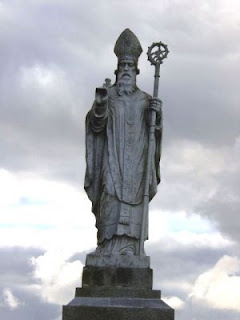I love St. Paddy’s Day! And in the spirit of green I thought I would count down with some fun
St. P’s Day facts.
First off
THE MAN BEHIND THE DAY
Saint Patrick's Day is an annual feast day that celebrates Saint Patrick himself. St. Pat is the patron saint and national apostle of Ireland.
St. Patrick was born in Britain to wealthy parents circa 380 a.d. He is believed to have died on March 17, around 460 A.D..
When Patrick was sixteen he was taken prisoner by a group of Irish raiders who attacked his family's estate. They took him to Ireland where he spent six years in captivity. During this time, he worked as a shepherd, outdoors and away from people. Lonely and afraid, he turned to his religion for solace. It is also believed that Patrick first began to dream of converting the Irish people to Christianity during his captivity.
After more six long years as a prisoner, Patrick escaped. According to his writing, a voice-which he believed to be God's-spoke to him in a dream, telling him it was time to leave Ireland.
To do so, Patrick walked nearly 200 miles to the Irish coast. After escaping to Britain, Patrick reported that he experienced a second revelation, an angel in a dream told him to return to Ireland as a missionary.
Patrick began religious training which lasted more than fifteen years. After his ordination as a priest, he was sent to Ireland with a dual mission-to minister to Christians already living in Ireland and to begin converting the Irish. (Interestingly, this mission contradicts the widely held notion that Patrick introduced Christianity to Ireland.)
Familiar with the Irish language and culture, Patrick chose to incorporate traditional ritual into his lessons of Christianity instead of attempting to eradicate native Irish beliefs. For instance, he used bonfires to celebrate Easter since the Irish were used to honoring their gods with fire. He also superimposed a sun, a powerful Irish symbol, onto the Christian cross to create what is now called a Celtic cross, so that veneration of the symbol would seem more natural to the Irish. He also used the shamrock to explain the Holy Trinity.
Saint Patrick is credited with bringing Christianity to Ireland. Most of what is known about him comes from his two works, the Confessio and Epistola. Saint Patrick described himself as a "most humble-minded man, pouring forth a continuous paean of thanks to his Maker for having chosen him as the instrument whereby multitudes who had worshipped idols and unclean things had become the people of God."
Saint Patrick is most known for driving the snakes from Ireland. It is true there are no snakes in Ireland, but there probably never have been - the island was separated from the rest of the continent at the end of the Ice Age. As in many old pagan religions, serpent symbols were common and often worshipped. Driving the snakes from Ireland was probably symbolic of putting an end to that pagan practice. While not the first to bring christianity to Ireland, it is Patrick who is said to have encountered the Druids at Tara and abolished their pagan rites. The story holds that he converted the warrior chiefs and princes, baptizing them and thousands of their subjects in the "Holy Wells" that still bear this name.
There are several accounts of Saint Patrick's death. One says that Patrick died at Saul, Downpatrick, Ireland, on March 17, 460 A.D. His jawbone was preserved in a silver shrine and was often requested in times of childbirth, epileptic fits, and as a preservative against the "evil eye." Another account says that St. Patrick ended his days at Glastonbury, England and was buried there. The Chapel of St. Patrick still exists as part of Glastonbury Abbey. Today, many Catholic places of worship all around the world are named after St. Patrick, including cathedrals in New York and Dublin city
Saint Patrick's Day has come to be associated with everything Irish: anything green and gold, shamrocks and luck. Most importantly, to those who celebrate its intended meaning, St. Patrick's Day is a traditional day for spiritual renewal and offering prayers for missionaries worldwide.
So take advantage of the holiday make it an opportunity for renewal and remember all of those missionaries in your prayers!



2 comments:
This was very informative and fun to read. Where do you get your information?!
Thank you Liz...i found most of it in the catholic saint catolog. The rest I found on various web sites.
Post a Comment